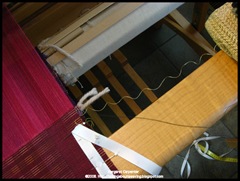Posted by Peg in South Carolina
In the art pieces I wove off of the current warp, I used only silk organzine for weft yarn. In the samples for the Crackle Exchange, however, I am using both bombyx silk (60/2) and silk organzine. I am using the organzine for the pattern wefts,  the bombyx silk for the background. My idea was to create a greater contrast between the pattern color and the background. But I am also curious as to what the drape of this cloth will be compared to the cloth where all the weft is organzine.
the bombyx silk for the background. My idea was to create a greater contrast between the pattern color and the background. But I am also curious as to what the drape of this cloth will be compared to the cloth where all the weft is organzine.
LIVELY WEFT YARN
While I was weaving, I noticed something that I had not observed before. I saw that the yellow organzine as it came off the bobbin was lively, keeping the curved shape it had developed on the bobbin. See the kinky yellow weft yarn in the photo. The dark green bombyx (lying over the breast beam), however, was quite limp; it retained no memory from having been on the bobbin.
I suspect this liveliness of the organzine contributes to the little loops that want to pop up in the woven fabric.
I have pretty much gotten control of this phenomenon. But one thing I see now is that when I use the organzine in an actual shuttle (end feed)I will have to tighten the tension on that shuttle more than I have to with the bombyx silk. Tightening the tension just a bit more will more strongly encourage the organzine to STAY FLAT!
Tightening the bobbin tension will doubtless have an effect on the selvedges, pulling the cloth in more. I will either live with that or I will use temples to deal with that issue.
OSTERKAMP ON KINKY YARN
Having recently had occasion to look at Osterkamp’s Volume Three (something I hadn’t done for a long time), I decided to see if she had anything to say on this problem. Well, yes indeed, she does have a great deal to say. She writes for two pages about “kinky” yarns, two pages in small type and with many helpful drawings (pages 138-139). She tells you how to test if the yarn is overtwisted, she discusses ways that the weaver might have inadvertently added twist to the yarn as she handled it, and she gives you ways to solve it. And one of these ways is the way I had decided to try. Here are her actual words:
You might use more tension than usual on kinky wefts, but don’t use so much that you cut in at the selvedges and the selvedge threads break. You might need to us a temple to prevent the selvedge threads from breaking.
And then, of course, she refers to the page in this volume where she discusses temples. I think this volume needs to be kept handy for awhile.
COLOR ACCURACY IN PHOTOS
Another observation: the colors of the weaving in this photo are much better than in the photo of the earlier post. Perhaps I need to play with the spot or spots the camera focuses on.
"Silk Organzine Yarn versus Bombyx Silk Yarn" was written by Margaret Carpenter for Talking about Weaving and was originally posted on September 22, 2008. © 2008 Margaret Carpenter aka Peg in South Carolina



2 comments:
Sometimes I turn off the flash in the camera and set the ISO to a slower speed to get acurate color photos. Although red, wine, orange and yellow are tough to photograph
I always have the flash turned off. I learned early on that the in-camera flash was not my friend! I rarely use ISO above 80, depending on the f-stopping that I am using. I am just beginning to work on learning histograms with the software and will then move to using the histogram on the camera. This is where I think my color reproduction will begin to improve.
Post a Comment